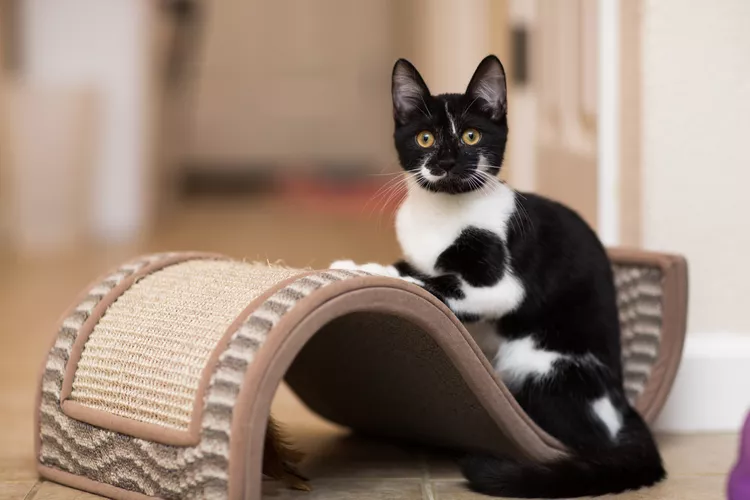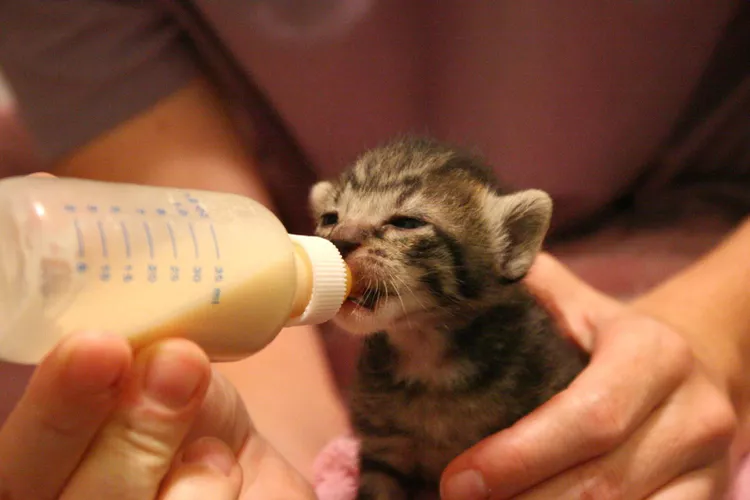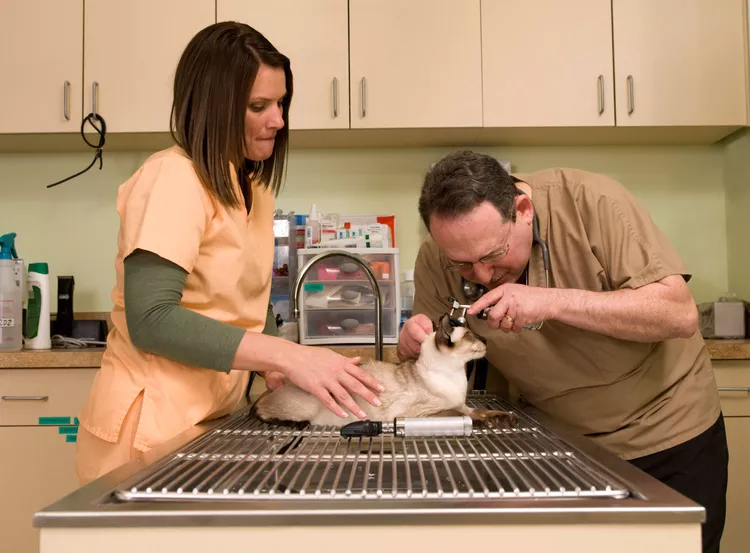Kittens are adorable and playful, but they're also unique individuals that have personalities, needs, and behaviors of their own. Before welcoming a new kitten (or kittens) to your home, you'll need to prepare your home for a curious critter with the ability to climb, leap, and scratch. You'll also need to provide your kitten with appropriate toys, bedding, litter boxes, and food.
If you're adopting a kitten that is 6 weeks old or older, it may have recently been weaned from its mother. Some kittens are orphaned, meaning they were separated from their mothers prematurely for some reason, which often happens with stray cats. These orphaned kittens are bottle-fed and cared for by animal shelters until they are old enough for adoption. In either case, kittens need to continue to be socialized and exposed to lots of different experiences to help them adjust well. This includes providing them with safe spaces to explore and keeping them away from unfamiliar dangers.
As a new kitten owner, your responsibility includes checking your home for potential dangers and providing appropriate and safe options for your pet. You'll also need to establish guidelines for kitten behavior and stick to them.
Kitten-Proof Your Home
Put on some comfortable old clothes and get way down on the floor and put on your best kitten persona. You can even lie on your back. Now look up; you'll likely see dozens of tempting attractions, many of them hazardous to tiny kittens.
Your first priority will be to remove serious hazards from your kitten's reach. Among the toughest to manage are electrical wires and outlets, many of which are at ground level. Kittens and cats are attracted to loose wires, so consider taping wires to baseboards or the underside of tables or desks. Other hazards include kitten-sized openings in floorboards and rocking chairs or gliders that can crush an unwary kitten. Make sure all windows have screens and repair any screens that have holes. Also find a secure place to put away any strings or threads such as knitting and sewing materials that can be very hazardous if ingested.
If you have ever had to set traps for ants or other pests, now is the time to be sure those traps are disposed of safely. You'll also want to check to be sure any breakable or precious items are above the reach of a leaping, climbing kitten.
During the initial adjustment period (at least seven to 10 days), it is a good idea to confine the kitten to a small room of the house. This room must be completely kitten-proofed as it should be the only room you leave your kitten in unsupervised at first. This allows your kitten to have a safe space to explore while you gradually introduce it to the rest of your home. This is especially important if you have other pets at home as they should be separated during this period to allow gradual, well-supervised interactions.
Shopping List for a New Kitten
Kittens don't need a great deal. Many are delighted to sleep on your bed or couch (if you've decided to allow that) and to play with a simple toy. You will, however, want to make a few purchases.
The Basic Necessities
At the very least, your kitten will need these basic necessities: food, a place to sleep, a scratching post or pad, and a litter box and litter. Of course, you won't be able to pass up a few toys. They will make the coming home experience a little easier on your new addition, especially since he'll be isolated from any other cats for the first few days. Create a shopping list for everything you'll need.
Cat Bedding Options
Your new kitten may be perfectly comfortable in a cardboard box lined with clean, soft towels or a small blanket, but you may consider giving him a real bed too, just like the big guys. The best bets are beds that are either fully washable or have a washable and/or replaceable cover. Don't spend a lot of money, though: there's an excellent chance that your kitten will pass up the bed you've prepared for the end of your bed, a spot on the couch, or any sunny corner of your home. Cats often like a place to hide, especially if they are nervous at first in a new place, so a bed with a cover, or a box of some kind is a good idea to help them feel secure while they are adjusting to their new digs.
Kitten Food for Kittens
The first year of a cat's life sets the pace for his future development, health, and well-being. It is essential that he eats a quality food developed for kittens.
At first, give him the same brand of food he's been eating at the breeders, foster home, or shelter, to avoid tummy upsets from sudden diet changes. If you intend to change the diet later, start by gradually mixing small amounts of the new food in with the current diet, increasing the amount of the new food each day over seven to 10 days. Use a small, low bowl so she can reach inside (many cat bowls are intended for larger adults). It's very important, too, to provide your kitten with plenty of clean, fresh water. Change the water each day, and consider investing in a low-cost "cat fountain" which recirculates water and is often more attractive to kittens than a simple bowl.
Interactive Toys
You're going to spend a lot of time in the first weeks bonding with your new kitten, establishing a close relationship that will last a lifetime. One of the best ways to start this bond is by playing with a kitten with an interactive toy. You can purchase everything from low-cost to very expensive items at the pet store, but don't forget another favorite game is "fetch" with a wadded-up piece of paper. Other fun simple toys include toilet paper rolls, paper bags, and the light from a flashlight or laser pointer that can be fun to chase. Always be careful as feathers, string, and other small parts can become choking hazards if they detach from toys so it is always important to supervise play closely.
Scratching Posts
It is not considered a humane practice to declaw cats so it is important to keep your kitty's nails in good health. This includes providing good scratching surfaces for them to shed the outer husks of their nails, and keeping up with regular nail trims. Some kittens will try to claw at your carpet or walls; to avoid damage to your home, you'll want to provide your kitten with a scratching post. A favorite "starting scratcher" among feline aficionados is the Cosmic Alpine Scratcher, an inexpensive, long-lasting cardboard incline with a corrugated cardboard scratching surface. Some cats prefer to scratch on horizontal surfaces, while others prefer vertical surfaces, so you may have to try a few options to find your cat's preference.
Litter Box and Litter
There are many litter boxes on the market, but make sure the one you choose is shallow enough for easy entrance and egress for your little guy. Many people use a small plastic storage box of appropriate size, for starters. If you are adopting a rescue kitten, ask the foster parents or shelter for advice about the best litter to use since it may be helpful to continue using what the kitty is familiar with. Bear in mind that some kittens will take time to adjust to their litter box, so you may also want to buy some pads to place around the box in case of accidents.
Preparing Yourself for Your New Pet
If you've never owned a kitten, you'll need to prepare yourself a bit for pet ownership. Unlike some other pets (fish and mice, for example), kittens need attention, companionship, and care. But that doesn't mean you need to turn your home over to your pet. In fact, just like human beings, kittens and cats thrive in settings where rules and expectations are clear. With that in mind:
- Be sure you and other family members have time to spend with your new pet.
- Agree as a family on the rules you'll be setting for your kitten. May she sleep on the furniture? What's your rule about jumping onto counters and tables?
- Where will your kitten spend the night? You may want to keep her in one location for the first few weeks, as it's easy to "lose" a kitten who decides to hide.
- Who is responsible for kitten care? From feeding to litter cleanup to grooming and vet care, kittens do require time, energy, and work. Who is responsible for which aspect of kitten care? Be sure you're all on the same page!




















